The iPad Air Review
by Anand Lal Shimpi on October 29, 2013 9:00 PM ESTGPU Performance
Since the iPad Air uses the same A7 silicon as the iPhone 5s, it also uses the same on-die GPU as the 5s: IMG’s PowerVR G6430. This is a 4-cluster configuration of IMG’s latest graphics hardware, running at some relatively high frequency. I already went into some detail on the G6430 in our 5s review so I won’t rehash that here, but we’re basically looking at a shift to a more efficient scalar architecture.
I still don’t have confirmations of clock speeds, but I believe we’re looking at a max GPU clock of around 450MHz. As you’ll see from the results below, there’s a small difference in performance between the iPad Air and iPhone 5s in terms of peak GPU performance - implying very similar clocks. The difference is the iPad Air should be able to sustain its max frequency longer than the iPhone 5s can.
| Mobile SoC GPU Comparison | ||||||||||||
| PowerVR SGX 554MP4 | PowerVR G6430 | PowerVR G6430 | ||||||||||
| Used In | iPad 4 | iPhone 5s | iPad Air | |||||||||
| SIMD Name | USSE2 | USC | USC | |||||||||
| # of SIMDs | 32 | 4 | 4 | |||||||||
| MADs per SIMD | 4 | 32 | 32 | |||||||||
| Total MADs | 128 | 128 | 128 | |||||||||
| GFLOPS @ 300MHz | 76.8 GFLOPS | 76.8 GFLOPS | 76.8 GFLOPS | |||||||||
| GFLOPS as Shipping | 68.1 GFLOPS (?) | 115.2 GFLOPS | 115.2 GFLOPS | |||||||||
Since we’re talking about an A7 here and not an X-series SoC, there’s still only a 64-bit wide memory interface. As memory bandwidth is a key enabler of GPU performance I was curious to see how GPU performance compared to the outgoing iPad 4 with its much wider memory interface. Do keep in mind that the A7 does include a large system cache on-die, which can help improve effective memory bandwidth.
GFXBench 2.7
We'll start our GPU performance analysis with a look at low level results using GFXBench/GLBenchmark 2.7. The low level tests, particularly the offscreen ones, should give us some idea as to whether or not there's any increase in GPU frequency for the iPad Air vs. iPhone 5s implementations of A7.
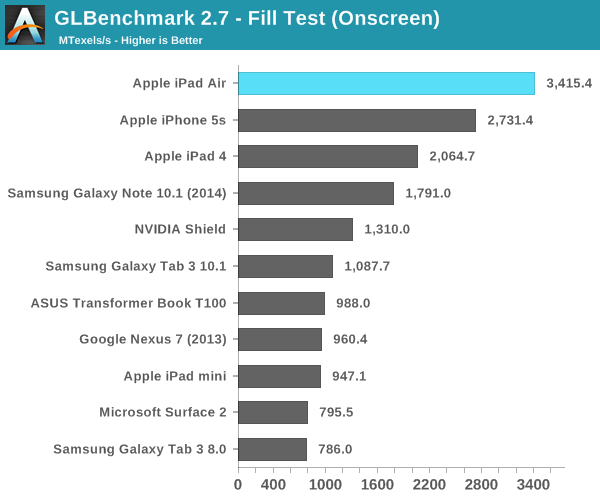
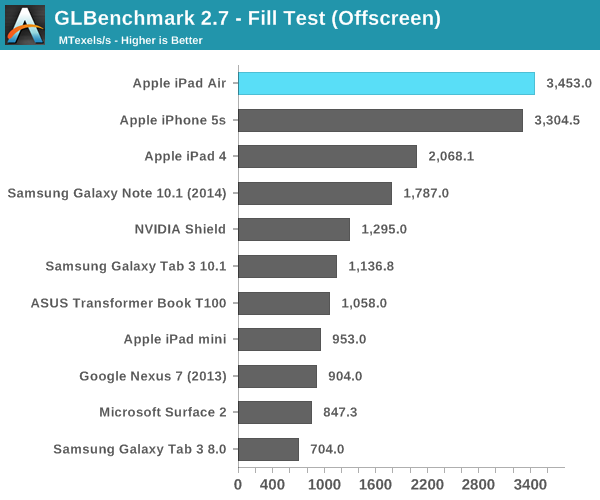
Looking at the fill rate results, there's a 4.5% increase in performance compared to the iPhone 5s. That could be the magnitude of clock increase that we're seeing between A7s. Apple could very well be relying on more thermal headroom in the iPad Air to provide any real world GPU performance advantages over the iPhone 5s.
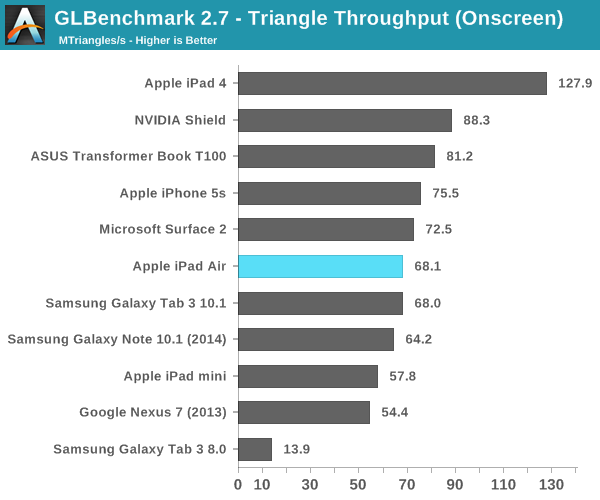

We see an even smaller gap between the Air and 5s in the triangle throughput tests (2.9%). There doesn't seem to be any substantial difference in GPU frequency between A7 implementations here. The regression in triangle rate performance compared to the iPad 4 is explained by differences in how Series 6 and Series 5XT GPUs scale in width. Whereas 5XT replicated nearly the entire GPU for "multi-core" versions, multi-cluster versions of Rogue only replicate at the shader array. The result? We don't see the same sort of peak triangle setup scaling we did back on multi-core 5XT parts. I'm not sure I'm particularly happy with the magnitude of the regression here, but I haven't seen any real world cases where it matters yet.
Next up are the game simulation tests. We'll start with the more strenuous of the two: T-Rex HD.
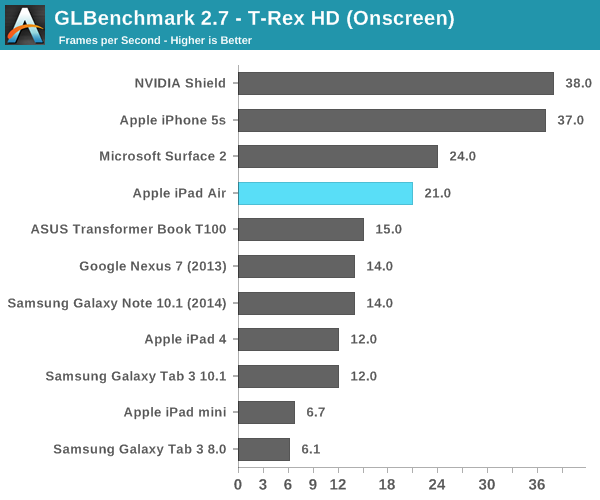
Here we get closer to Apple's claims of a 2x increase in performance. The iPad Air delivers 75% more performance than the iPad 4 in this test. Once again the iPhone 5s pulls ahead but that's because the onscreen tests render at display resolution, which is lower on the 5s.
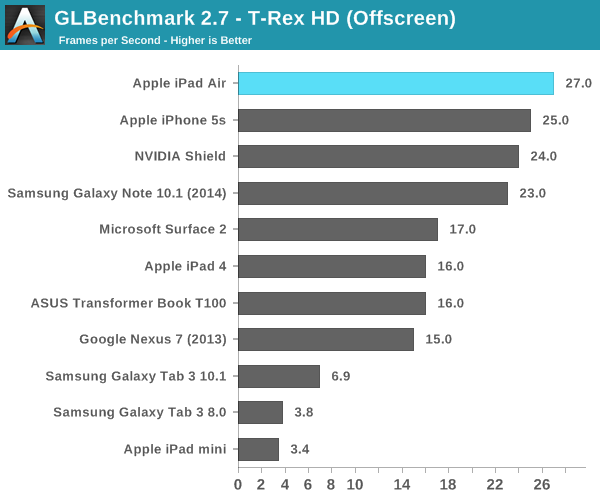
Offscreen performance sees similar scaling: ~69% better performance compared to the iPad 4.
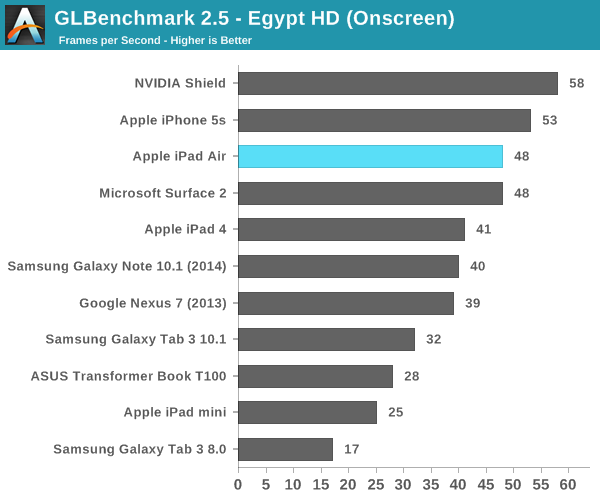
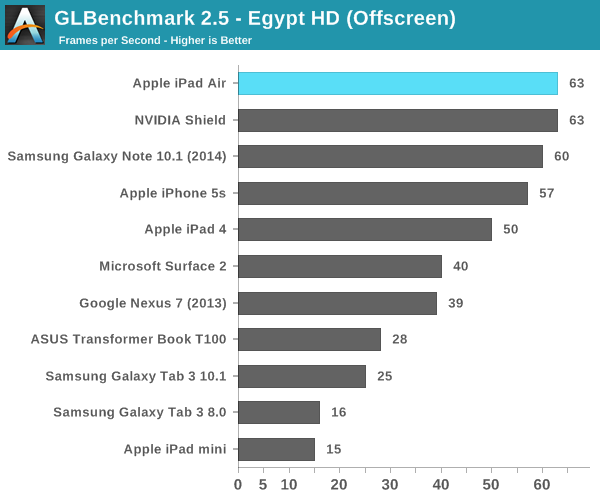
3DMark
We're once again running 3DMark's newest Unlimited mode which does its best to run independently of v-sync and at a standard resolution across all devices. I've also included 3DMark Extreme results below that feature a few more comparison points.
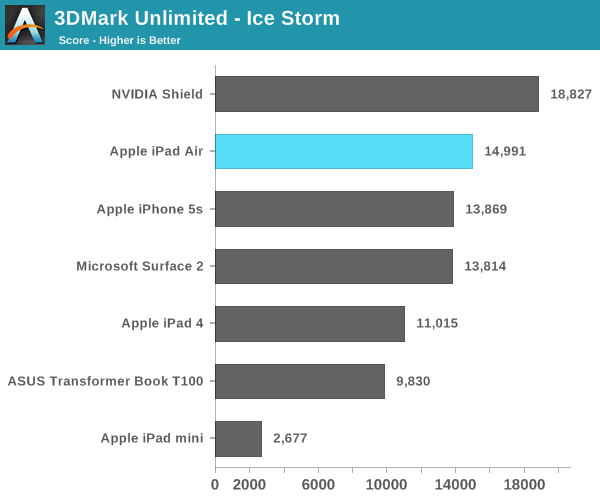
The overall Ice Storm scores show a 36% improvement in performance over the iPad 4 and an 8% increase compared to the iPhone 5s. Given the CPU frequency advantage of the A7 in the Air vs. the iPhone 5s, I'm guessing that's why we're seeing the performance gap we are here.
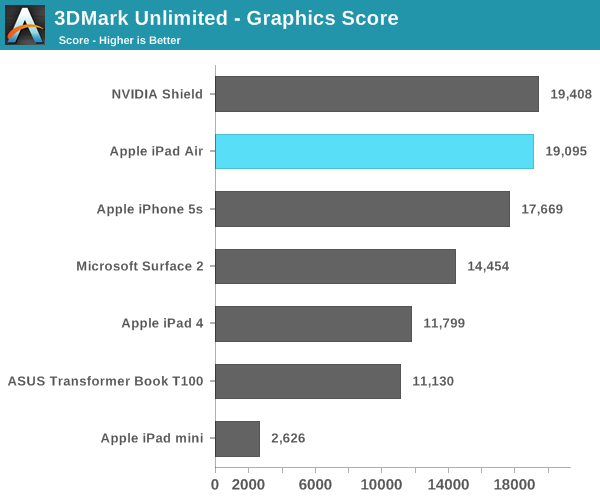
If we focus exclusively on the GPU tests (which themselves are still CPU bound), the iPad Air's performance advantage over the iPad 4 grows to over 60%.
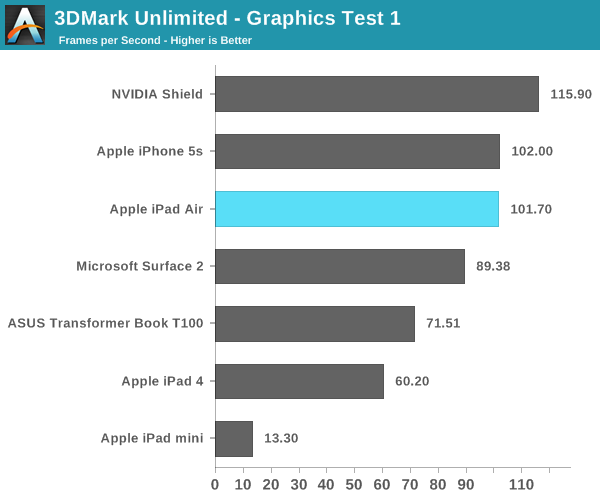
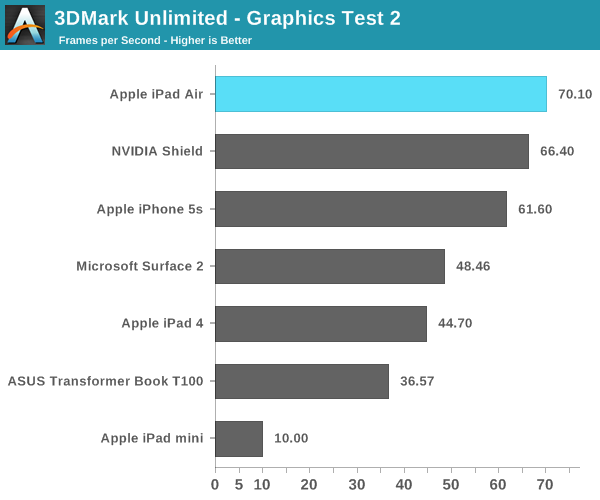
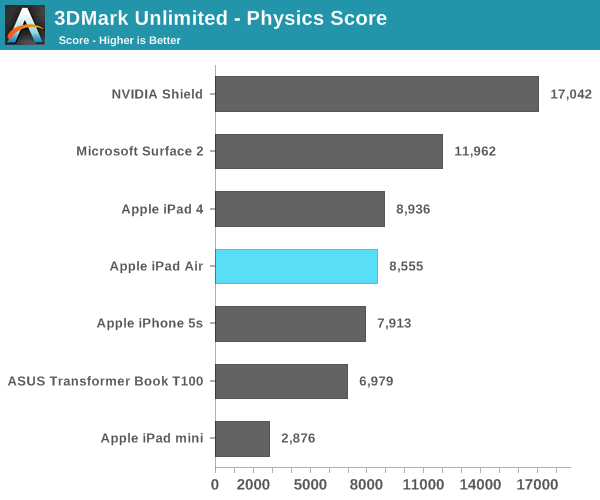
I'm still not entirely sure what's going on with the 3DMark Physics test, but we've seen this two reviews in a row now where Cyclone showed no performance increase at all compared to Swift despite this being largely a CPU test.
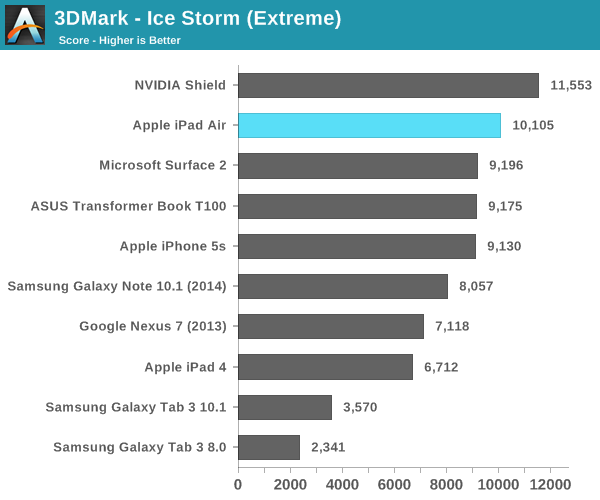
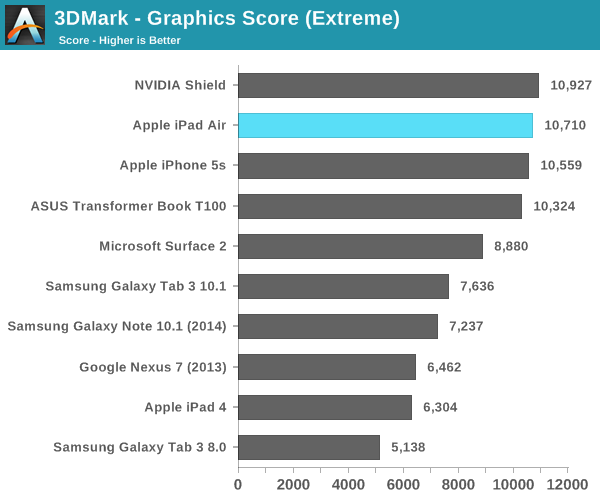
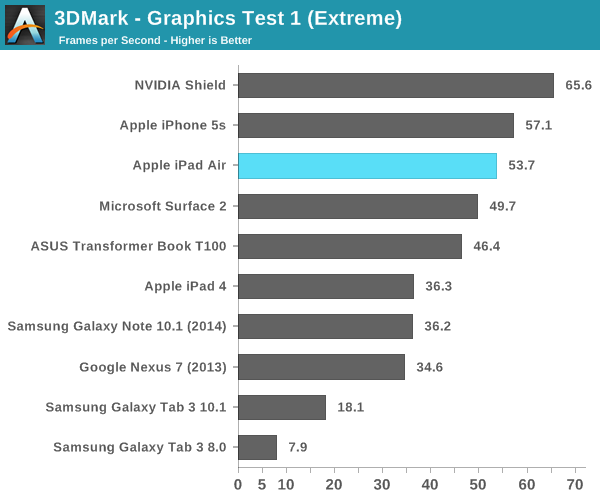
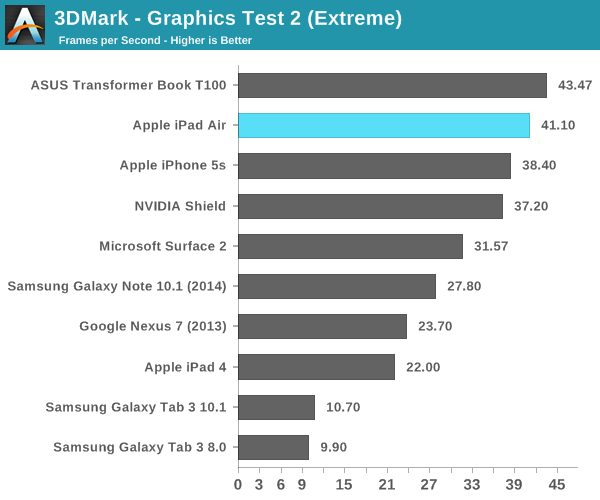

Basemark X
Basemark X is a new addition to our mobile GPU benchmark suite. There are no low level tests here, just some game simulation tests run at both onscreen (device resolution) and offscreen (1080p, no vsync) settings. The scene complexity is far closer to GLBenchmark 2.7 than the new 3DMark Ice Storm benchmark, so frame rates are pretty low.
I'm still having random issues with Basemark X reliably running both on and offscreen tests on iOS 7. Unfortunately I could only get onscreen results for the iPad Air, which came in at 46% faster than the iPad 4. Note the iPad mini and iPhone 5s benefit from having lower native resolutions here, which is why they perform so well.
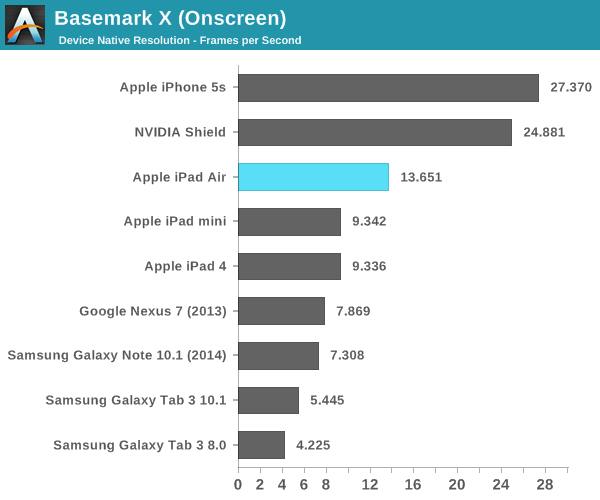










444 Comments
View All Comments
zogus - Tuesday, October 29, 2013 - link
Well, I've never had an iDevice crash on me , and I've owned iPhones since 2008.You know what they say about anecdotal evidences.darkcrayon - Wednesday, October 30, 2013 - link
I'm not sure if Anand meant a total system crash, or if he meant an app crashing due to memory use (iOS actually kills apps that request too much memory if they go overboard such that the system can't be maintained- since there is no swap file).basroil - Tuesday, October 29, 2013 - link
"It also seemed like 15-inch notebook computers were done for a couple of years ago, then Apple launched the MacBook Pro with Retina Display. "The year after, due to poor sales of the 15" model, Apple succumbed to the market and released a 13" model to offset losses.
blacks329 - Wednesday, October 30, 2013 - link
Really? So it only took them 4.5 months to go from no plan of ever releasing a 13" inch retina MBP to going through all the processes required to make and release it, because the 15" was losing money? What world do you live in? You have no idea what you're talking about.tipoo - Tuesday, October 29, 2013 - link
30% higher memory use is pretty huge, and on the same 1GB, 1GB 32 bit iOS devices already kicked Safari tabs out of memory and forced refreshes far more than I would like.ScottBoone - Tuesday, October 29, 2013 - link
Being an original iPad owner, I think the RAM situ on the iPad Air is going to turn out to be its achilles heal, just like the original. And when the original iPad first shipped, nearly ALL the reviewers bought the Apple PR line that "specs don't matter" blah blah blah. And sure enough, specs ABSOLUTELY mattered; the original iPad saw a premature end of life. All of the reviews **EXCEPT Anand's** have completely ignored the question of RAM: completely ignoring the fact that the iPad 3/4 already suffered from more RAM constraint than the 2 (thanks to the increased buffer size needed for the Retina screen), completely ignoring the 20-30% bigger footprint of 64-bit computing, completely ignoring that newer apps/iOS are bigger/hungrier beasts. Apple has a terrible track record of memory efficiency; I can't imagine the newest versions of iMovie and GarageBand using LESS RAM than their predecessors. Forget about the NEXT versions being more frugal. Given that the difference between the original iPad's inability to run iOS 6 (not to mention iOS 7) was 256MB of ram (under iOS 5, the original iPad has ~70MB free after device boot), and compounding the increased footprint of the buffers, iOS usage, and app growth...I can't imagine the iPad Air is going to be a long-term viable device. I'd be surprised if it enjoys a good user experience under iOS 9 (rather like the original iPad under iOS 5). Personally, I don't think Anand hammers Apple's choice of 1GB hard enough here, I guess only time will tell.aliasfox - Wednesday, October 30, 2013 - link
+100I'm typing this on an iPad 1. A 32GB iPad 1 with 3G, so a $700+ device. The 256MB of RAM is crippling. Even my iPhone 4, using the same chip but 20% slower and with twice the RAM, is much more usable for a lot of activities. In fact, the Facebook app automatically crashes on the iPad nine times out of ten on the iPad, but is perfectly fine on the iPhone. Aside from RAM, they're just about the same.
I love using my iPad when it works, but if I'm only going to get three years tops out of a device, you're gonna have a hard time convincing me to spend $700 on one again. Even $500 is a stretch.
KoolAidMan1 - Wednesday, October 30, 2013 - link
Should have sold it when the 2 came out. The iPad 2 is still a viable device after all this time, mainly because of the RAM situation.The original iPad is like the original iPhone 3G, good for a year but far surpassed by a predecessor with much more longevity.
aliasfox - Wednesday, October 30, 2013 - link
Would've, should've, could've. Now the resale value of a first generation iPad is less than the difference between a 16GB wifi and a 32GB LTE model. I like having more space and true GPS (not to mention occasional cellular usage), so it would be mildly annoying to go from a cellular model to a wifi only model. Sure, a lot of that could be made up for by the phone (which I got over a year after my iPad), but still...Maybe a cheaper iPad mini Retina would work better, despite the smaller screen size.
darkcrayon - Wednesday, October 30, 2013 - link
Yeah the iPad 1 had a premature demise, that was a mistake, but I don't think we're going to see that with the Air- I mean the iPad 2 had a much longer lifespan (hell, it's still being sold). But you could/should just sell your iPad after a year or two and use the money to upgrade. Mobile is clearly on a much faster growth schedule than traditional computers, tablets being somewhere closer to phones than laptops.